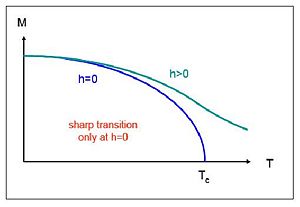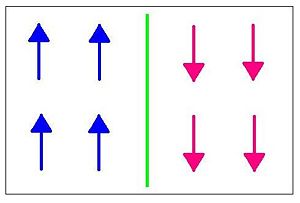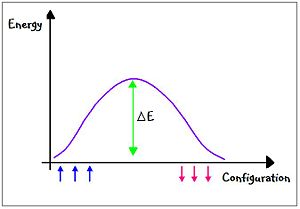PHZ3400 Midterm Two Solution
PHZ 3400 – Midterm Two Exam (with solutions) – April 10, 2009
Problem 1
Explain the concept of the "Thermodynamic Limit", and present the corresponding domain wall argument (derivation of a formula) to estimate the relaxation time as a function of system size, at T < Tc.
The partition function which applies in this case is where n = the number of particles.
However, symmetry breaking, including phase transitions, cannot occur for any finite system[1]. Thus systems must be sufficiently large, , in order to reach the thermodynamic limit and for spontaneous symmetry breaking to occur.
Suppose we start in a ferromagnetic system where all of the spins are up and we would like to make them spin down. This can be done by applying a domain wall to the system. The image to the left shows the most energetically favorable configuration of the system. This can be further described by the image to the right, which shows the probability of the system being in those states. Notice that the image shows the system is most likely to be found in a state where there is a mix of up and down spins. The domain wall will, by its nature, try to find the most energetically favorable state and it will thus lie where the energy of the probability of the states of the system is at a maximum.
Probability is represented mathematically as where E is the energy and T is the Temperature. When there is random motion, .
Since we are dealing with a domain wall, we can replace E with , which is also defined as where is the surface tension J--the interaction between spins, and L is the size of the system.
With this substitution, we get .
d is the dimension, so for a three dimensional case we get . The variable is the relaxation time, and the equation gives a relationship between the relaxation time and the size of the system.
The relaxation time and the size of the system have a direct correlation, as the size of the system increases the orelaxation time also increases, albeit at a greater rate. Thus if the size of the system is very large (macroscopic objects) then the relaxation time becomes larger than the age of the universe, and the system will stay in its current state.
Another interesting relation is between the relaxation time and temperature. As the temperature gets lower, the relaxation time gets larger. This fits in well with superconductors since they are only conducting at low temperatures. This means that as the semiconductors cool down the spins align and exhibit symmetry breaking.
[1] [http://prola.aps.org/abstract/PR/v87/i3/p404_1 C. N. Yang and T. D. Lee, Statistical Theory of Equations of State and Phase Transitions. I. Theory of Condensation Phys. Rev. 87, 404 - 409 (1952)]
Problem 2
Sketch the magnetization of a ferromagnet as a function of temperature T, for (A) Zero external magnetic field and (B) Finite external magnetic field. How is the behavior around the Curie Temperature (Tc) affected by the field?

(A) For zero external magnetic field, the magnetization of a ferromagnet as a function of temperature T should go to the Curie Temperature (Tc).
The Tc will be unique based on the ferromagnet.
Problem 3
Consider a solid with vibrations well described by the "Einstein Model", where a single vibrational frequency is considered. [Note: Phonons obey Bose-Einstein statistics.]
(A) What is the density of phonons with this frequency as a function of the temperature T? Sketch this function.
(B) What is the phonon density at very low temperatures?
(C) What is the phonon density at very high temperatures?
(D) Assuming that the scattering rate of electrons in such a solid is simply proportional to the density of phonons, determine the temperature dependence of resistivity at high temperatures.
Problem 4
Consider a neutron star of radius R = 10km, and mass M = 3x1030 kg (approximately 1.5 solar masses). Given that the mass of a single neutron is m=1.7*10-27 kg, that h-bar = 1x10-34 m2 kg/s, and that neutrons obey Fermi-Dirac Statistics, calculate:
a. The number density n=N/V of this star. N = total number of objects in volume V. Using this, we first can find the volume of the neutron star.
b. Derive in detail the relation between Fermi energy and the number density.
- .
For a 3-D object, in this case a sphere,
where the factor 2 comes from the fact that there are 2 spin states, 1/8 comes from the fact that only 1/8 of the sphere is positive, and comes from the volume of the sphere with radius
Solving for and then substituting into yields
and then finally
In order to get this in terms of number density, we substitute L2 with V2/3.





















